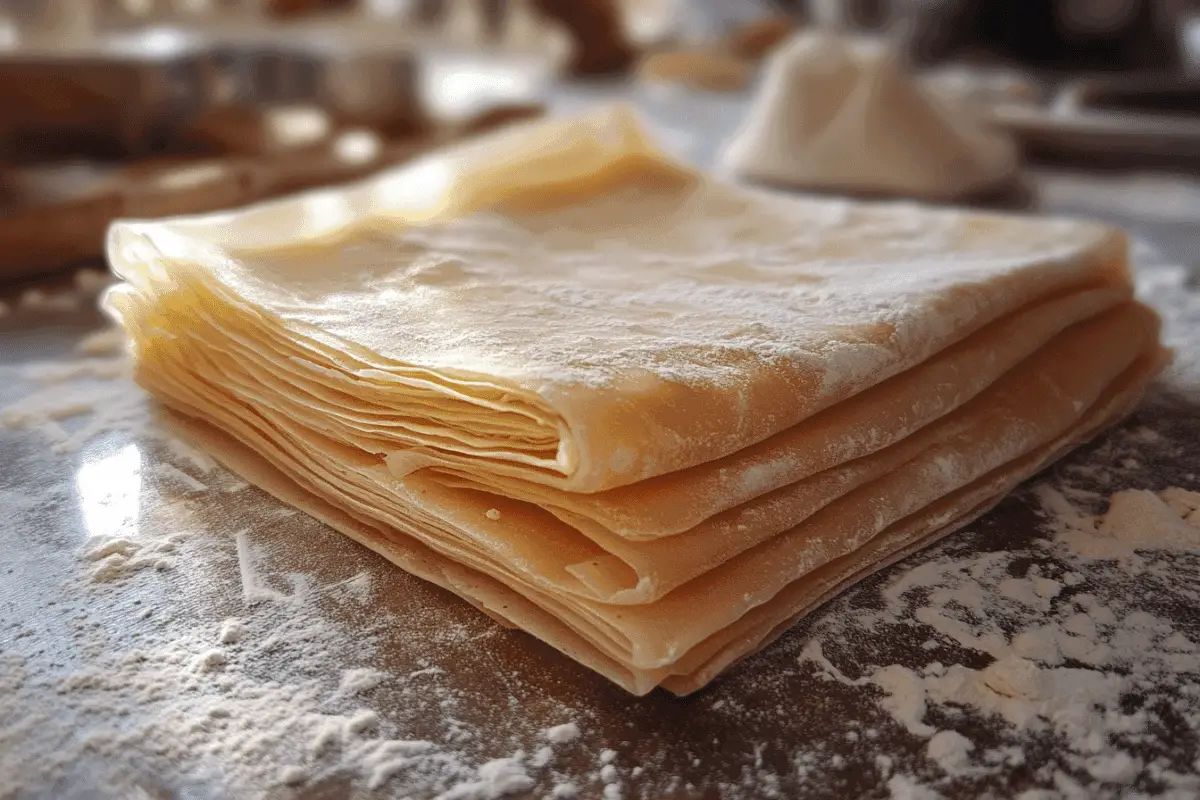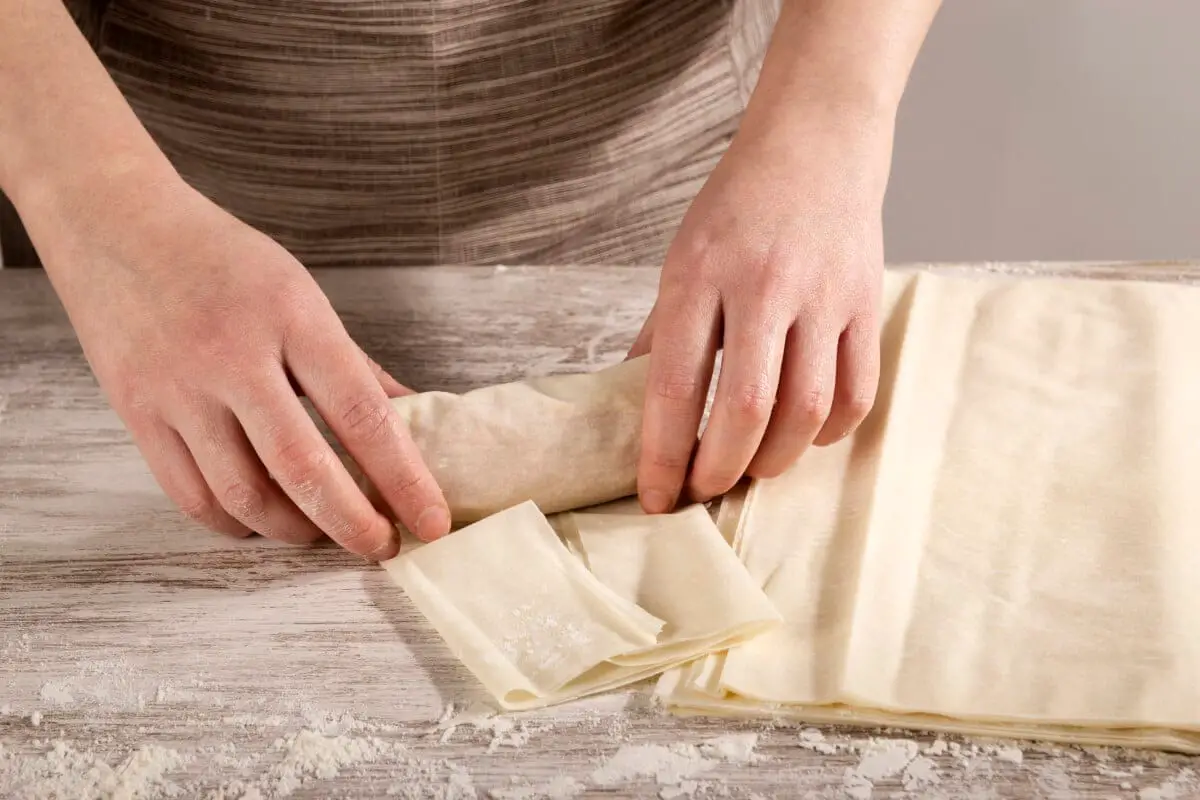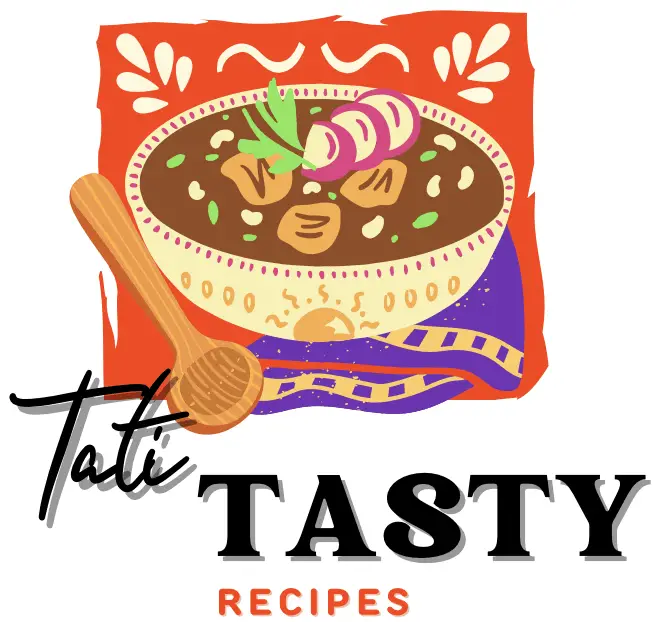
Phyllo dough is a versatile and delicate pastry that has played a crucial role in various cuisines for centuries. In fact, people know it for its paper-thin layers and crisp texture. Moreover, this dough serves as the foundation for many traditional dishes, such as baklava and spanakopita. Whether you’re a seasoned baker or a culinary novice, mastering phyllo will undoubtedly open up a world of delicious possibilities.
What is Phyllo Dough?
Phyllo, also known as filo, is a type of unleavened dough that you roll out to a paper-thin consistency. Cooks in Middle Eastern, Greek, and Balkan cuisines commonly create this dough from flour, water, and a small amount of oil or vinegar. As a result, they stretch it by hand until it becomes almost translucent. When you bake the thin layers, they puff up slightly, resulting in a flaky, crisp texture.
For those interested in more Mediterranean-inspired dishes, you might also enjoy our recipe for Shrimp Spring Roll Recipe.
How to Work with Phyllo Dough
- Thawing Phyllo
Phyllo dough typically comes frozen, so you need to thaw it before use. It’s important to note that thawing it slowly in the refrigerator for several hours or overnight prevents the layers from sticking together.
If you’re looking for other frozen dough recipes, consider exploring our guide on Easy Puff Pastry Recipes.
- Handling and Storing Phyllo
Working with phyllo can be tricky due to its delicate nature. However, here are some tips:
- First, keep it covered: Phyllo dries out quickly, so keep the sheets covered with a damp cloth while you work.
- Second, use a light touch: Handle the sheets gently to avoid tearing them.
- Finally, store leftovers properly: Wrap unused phyllo tightly in plastic wrap and store it in the refrigerator for up to a week.

Phyllo Dough Recipes
- Baklava
One of the most famous dishes made with phyllo is baklava, a rich, sweet dessert made with layers of phyllo, chopped nuts, and honey. Consequently, the combination of the flaky pastry and sweet filling makes it a beloved treat around the world.
If you enjoy desserts like baklava, you might want to try our recipe for Sun-Dried Tomato and Feta Stuffed French Toast, which offers a savory twist on a classic.
- Spanakopita
Spanakopita is a Greek savory pie made with phyllo, spinach, feta cheese, and herbs. Indeed, the crispy layers of phyllo contrast beautifully with the creamy, flavorful filling, making it a popular appetizer or main course.
For a lighter side dish, consider pairing it with our Mediterranean Quinoa Power Bowl.
Frequently Asked Questions (FAQs)
- What is the best way to store phyllo dough?
You should store phyllo in its original packaging in the refrigerator or freezer. However, if you open the package, wrap the remaining sheets tightly in plastic wrap and store them in the refrigerator for up to a week.
- Can phyllo dough be made at home?
Yes, you can make phyllo dough at home, but it requires practice to roll the dough out thinly enough. Nonetheless, many people prefer to use store-bought phyllo for convenience.
- What are some common mistakes when working with phyllo dough?
Common mistakes include letting the dough dry out, tearing the sheets, and not using enough butter or oil between layers, which can result in a less flaky texture.
- Can I use phyllo for savory dishes?
Absolutely! In fact, phyllo dough is incredibly versatile and can be used for both sweet and savory dishes, such as spanakopita, samosas, and meat pies.
The History and Cultural Significance of Phyllo Dough
Phyllo dough has a rich history that dates back centuries, deeply rooted in Middle Eastern, Greek, and Balkan cuisines. Interestingly, the word “phyllo” itself comes from the Greek word for “leaf,” symbolizing its delicate, thin layers. Moreover, it is believed that the technique of making phyllo dough originated in the kitchens of the Ottoman Empire, where chefs meticulously hand-stretched the dough to achieve its signature paper-thin consistency.
As a result, phyllo became a cornerstone of traditional dishes like baklava, symbolizing hospitality and celebration. Additionally, in many cultures, phyllo-based dishes are served during special occasions such as weddings, religious holidays, and family gatherings. Furthermore, its versatility allows it to bridge culinary traditions, making it a beloved ingredient worldwide.
Tips for Success When Working with Phyllo Dough
Working with phyllo dough can feel intimidating, but with the right approach, you can achieve flawless results. Here are some additional tips:
- Keep Your Workspace Organized
Before you begin, gather all your ingredients and tools. By doing so, you can work quickly and efficiently, preventing the dough from drying out. - Brush with Precision
Use a soft pastry brush to apply butter or oil between each layer. This step not only enhances flavor but also ensures a crispy texture. - Avoid Overloading Fillings
When creating dishes like spanakopita or samosas, use a moderate amount of filling to prevent the phyllo from tearing or becoming soggy. - Practice Makes Perfect
If you’re new to working with phyllo, start with simpler recipes like turnovers or small tarts before attempting complex layered dishes.
Ultimately, mastering these techniques will boost your confidence and make working with phyllo an enjoyable experience.
Creative Uses for Phyllo Dough
Phyllo dough’s versatility makes it perfect for experimenting with new recipes. Below are some creative ideas to inspire your next culinary adventure:
- Phyllo Pizza Bites
Layer phyllo sheets to form a crispy base, then top with marinara, cheese, and your favorite toppings for a unique twist on pizza night. - Savory Phyllo Cups
Bake phyllo in muffin tins to create edible cups that you can fill with ingredients like hummus, roasted vegetables, or smoked salmon. - Dessert Rolls
Fill phyllo sheets with sweetened cream cheese and berries, roll them up, and bake until golden for a quick and delicious dessert. - Breakfast Strudel
Combine scrambled eggs, cheese, and cooked bacon or veggies, wrap them in phyllo, and bake for an impressive brunch dish.
Additionally, experimenting with phyllo allows you to create dishes that are both visually appealing and full of flavor.
Nutritional Benefits of Phyllo Dough
Phyllo dough offers a lighter alternative to other pastries, such as puff pastry. Notably, it is lower in fat and calories because it doesn’t contain butter or shortening in the dough itself. Here’s a quick breakdown:
- Calories: Approximately 50-70 calories per sheet
- Fat Content: Minimal, especially compared to traditional pie crusts
- Carbohydrates: Provides energy while remaining light and flaky
Moreover, when paired with nutrient-rich fillings like vegetables, lean proteins, or nuts, phyllo-based dishes can be a part of a balanced diet. For instance, spanakopita offers a nutritious blend of spinach, feta, and herbs, making it both delicious and wholesome.
Comparing Phyllo Dough to Puff Pastry
While phyllo dough and puff pastry may look similar, they differ in composition and use:
- Texture
Phyllo is thin and crisp, whereas puff pastry is buttery and flaky due to its layers of fat. - Preparation
Puff pastry requires careful folding and chilling, while phyllo is stretched thin and layered with butter or oil during use. - Calories and Fat
Phyllo is lighter, making it ideal for health-conscious recipes, while puff pastry is richer and more indulgent.
Consequently, understanding these differences can help you choose the best option for your recipe, depending on the desired texture and flavor.
Pairing Phyllo-Based Dishes with Beverages
To elevate your phyllo-based dishes, consider these beverage pairings:
- Desserts like Baklava
Pair with strong coffee or sweet dessert wines like Sauternes or Moscato. The sweetness of the baklava complements the bold flavors of these beverages. - Savory Dishes like Spanakopita
Enjoy with a crisp white wine, such as Sauvignon Blanc, or a light beer to balance the richness of the filling. - Appetizers
Serve with sparkling water infused with citrus or herbs for a refreshing non-alcoholic option.
Ultimately, the right pairing enhances the dining experience and complements the flavors of the dish.
Exploring International Dishes Using Phyllo Dough
Phyllo dough is used in a variety of dishes around the globe. Here are some regional favorites:
- Turkey
Börek is a popular savory pastry filled with cheese, meat, or spinach. - Middle East
Baklava and kunafa are traditional desserts layered with nuts and syrup. - Eastern Europe
Strudel, filled with apples or cherries, is a classic dessert in this region.
By exploring these international dishes, you can expand your culinary repertoire and appreciate the versatility of phyllo dough.
Storage and Reheating Tips for Phyllo Dishes
To enjoy your phyllo-based dishes at their best, follow these storage tips:
- Refrigeration
Store leftover dishes in an airtight container in the refrigerator for up to three days. - Freezing
Freeze fully assembled but unbaked dishes, then bake directly from frozen to maintain freshness. - Reheating
Reheat in an oven at 350°F (175°C) to restore crispness, avoiding microwaves which can make the dough soggy.
By adhering to these tips, you can extend the life of your phyllo creations and enjoy them at their peak.
Conclusion
In conclusion, phyllo dough is a unique and versatile ingredient that can elevate a wide range of dishes, from sweet desserts to savory pies. With a little practice and patience, you can master the art of working with phyllo dough and impress your family and friends with your culinary creations.
For more recipes and tips on working with dough, check out our full collection at Tati Tasty Recipes.
